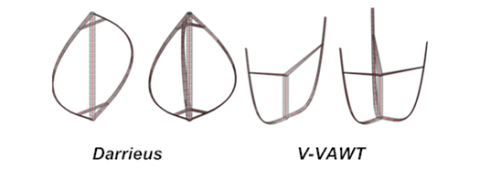For the past few years, much of the U.S. Department of Energy’s (DOE’s) Wind Program research and development efforts have been focused on accelerating the development and deployment of offshore wind energy technology. In 2011, DOE awarded $43 million to 41 projects across 20 states to speed technical innovations, lower costs, and shorten the timeline for deploying offshore wind energy systems. Nineteen of those projects were focused on addressing technical challenges and providing the foundation for a cost-competitive offshore wind industry in the United States. Although many of these projects are not scheduled for completion until the 2016–2017 timeframe, research results are starting to trickle in. This section of the Wind Program Newsletter includes updates, information, and results from those projects. Project updates in this edition of the newsletter include the vertical-axis offshore wind turbine study by Sandia National Laboratories and the Simulator for Offshore/Onshore Wind Farm Applications, a computer-aided engineering tool developed by the National Renewable Energy Laboratory.
Sandia National Laboratories and Partners Complete Phase I of a Vertical-Axis Deepwater Offshore Turbine Study
Sandia National Laboratories and partners from the University of Maine, Technical University of Delft, Iowa State University, TPI Composites, and Texas A&M University have completed the first phase of a project to explore the feasibility of large-scale vertical-axis wind turbines (VAWTs) for deepwater offshore locations. The results of this conceptual study showed the potential for significant cost of energy reduction in the deepwater offshore environment for VAWTs. Component cost models were developed to perform a levelized cost of energy (LCOE) analysis, which was then employed to gain a better understanding of opportunities for cost reduction and tradeoffs in the design space for offshore VAWTs.
The major accomplishments of this project included:
- Development of design codes for floating offshore VAWT systems
- Identification of driving wind and wave design conditions and standards
- Studies for floating VAWT system design concepts
- Innovations and analysis to mitigate technical challenges.
The initial phase of the work also produced new developments for large-scale deepwater offshore VAWT technology in the following areas:
- VAWT design codes (Updated set to include structural, aerodynamic, aeroelastic, and hydrodynamic/mooring)
- Rotor structural dynamics and platform design studies
- Novel VAWT airfoil design
- Aeroelastic stability tool development and stability estimates
- Balance-of-station cost reduction
- New approaches for storm survival and load alleviation.
Cost and performance tradeoffs between various rotor configurations and floating platform options were examined in the initial project phase.
Currently, plans are being made for the next phase of the work, which include enhancements to the suite of VAWT codes developed in Phase I as well as detailed design studies and up-scaling of rotor and platform concepts. In addition, promising LCOE reduction pathways identified in the initial phase will be explored in the design studies.
Computer-Aided Engineering Tools Model Offshore Wind Turbines, Substructures, and Wind Farms
Several of the research projects funded by DOE’s Offshore Wind Technology Development Funding Opportunity are contributing to the development of computer-aided engineering tools that the wind industry is using to advance the development of offshore wind technologies. The National Renewable Energy Laboratory (NREL) recently released one of these new tools—the new Simulator for Offshore/Onshore Wind Farm Applications (SOWFA).
SOWFA is a unique simulation framework that allows users to investigate the effects of weather patterns, turbulence, and complex terrain on the performance of wind farms as well as individual wind turbines. It combines various open-source software programs, including a weather researching and forecasting model, a computational fluid dynamics model, and the FAST wind turbine performance simulator into a package that produces both high- and medium-fidelity wind farm simulations. SOWFA’s high-fidelity mode requires a high-performance computing cluster and considerable expertise to run. It allows researchers to examine select situations in great detail to understand complex wind farm physics. SOWFA’s medium-fidelity mode requires only a laptop to run. Developers can use it for a less detailed examination of the wind farm environment by switching out the wind farm atmospheric simulation (OpenFOAM) module for a dynamic wake meandering (DWM) and TurbSim module. The DWM model simulates the wakes of the wind turbines so that developers can study the interaction between multiple turbines in a wind farm. TurbSim models the atmospheric turbulence and inflow.
SOWFA enables engineers and developers to understand the causes of wind plant underperformance and how to increase power output and decrease the effects of loads to minimize wear on turbine components, all of which would contribute to significant decreases in cost for both offshore and land-based wind energy development. It also enables wind turbine manufacturers to study wind turbine designs before they are manufactured and installed in the field and wind plant developers to study the performance of turbines on a proposed site before it’s built, greatly reducing the risks of development and deployment.
SOWFA is available to wind technology developers free of charge on NREL’s Computer-Aided Engineering Tools web page.

